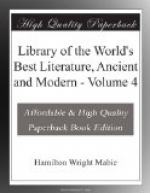Their first joint play, ‘Philaster, or Love Lies a-Bleeding,’ acted in 1608, is in its detached passages the most famous. Among the others, ‘The Maid’s Tragedy,’ produced about the same time, is their finest play on its purely tragic side, although the plot is disagreeable. ’King and No King’ attracts because of the tender character-drawing of Panthea. ‘The Scornful Lady’ is noteworthy as the best exponent, outside his own work, of the school of Jonson on its grosser side. ’The Knight of the Burning Pestle’ is at once a burlesque on knight-errantry and a comedy of manners.
Among the tragedies presumably produced by Fletcher alone, ‘Bonduca’ is one of the best, followed closely by ‘The False One,’ ‘Valentinian,’ and ‘Thierry and Theodoret.’ ‘The Chances’ and ‘The Wild Goose Chase’ may be taken as examples of the whole work on its comic side. ’The Humorous Lieutenant’ is the best expression of the faults and merits of Fletcher, whose comedies Swinburne has divided into three groups: pure comedies, heroic or romantic dramas, and mixed comedy and romance. To the first group belong ‘Rule a Wife and Have a Wife,’ Fletcher’s comic masterpiece, ‘Wit without Money,’ ‘The Wild Goose Chase,’ ‘The Chances,’ ‘The Noble Gentleman.’ The second group includes ‘The Knight of Malta,’ full of heroic passion and Catholic devotion, ‘The Pilgrim,’ ’The Loyal Subject,’ ‘A Wife for a Month,’ ‘Love’s Pilgrimage,’ ’The Lover’s Progress.’ The third group comprises ‘The Spanish Curate,’ ’Monsieur Thomas,’ ‘The Custom of the Country,’ ‘The Elder Brother,’ ’The Little French Lawyer,’ ‘The Humorous Lieutenant,’ ‘Women Pleased,’ ’Beggar’s Bush,’ ‘The Fair Maid of the Inn.’
Fletcher had a part with Shakespeare in the ‘Two Noble Kinsmen,’ and he wrote also in conjunction with Massinger, Rowley, and others; Shirley, too, is believed to have finished some of his plays.
Leaving aside Shakespeare, Beaumont and Fletcher’s plays are the best dramatic expression of the romantic spirit of Elizabethan England. Their luxurious, playful fancy delighted in the highly colored, spicy tales of the Southern imagination which the Renaissance was then bringing into England. They drew especially upon Spanish material, and their plays are rightly interpreted only when studied in reference to this Spanish foundation. But they are at the same




